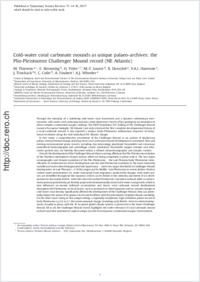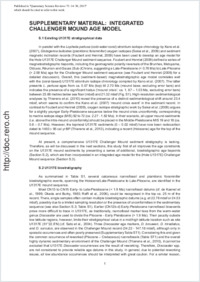Cold-water coral carbonate mounds as unique palaeo-archives: the Plio-Pleistocene Challenger Mound record (NE Atlantic)
- Thierens, M. School of Biological, Earth and Environmental Sciences & The Environmental Research Institute, University College Cork, Ireland
- Browning, E. Department of Geosciences, University of Massachusetts, Amherst, USA
- Pirlet, H. Renard Centre of Marine Geology, Department of Geology and Soil Science, Ghent University, Belgium -
- Loutre, M.-F. Université catholique de Louvain, Belgium
- Dorschel, B. School of Biological, Earth and Environmental Sciences & The Environmental Research Institute, University College Cork, Ireland
- Huvenne, V.A.I. Geology & Geophysics, National Oceanography Centre, Southampton, UK
- Titschack, J. MARUM, Center for Marine Environmental Sciences, University of Bremen, Germany - Senckenberg am Meer, Abteilung fur Meeresforschung, Wilhelmshaven, Germany
- Colin, C. Laboratoire Interactions et Dynamique des Environnements de Surface, Université de Paris XI, France
- Foubert, Anneleen Department of Geosciences – Earth Sciences, University of Fribourg, Switzerland
- Wheeler, A.J. School of Biological, Earth and Environmental Sciences & The Environmental Research Institute, University College Cork, Ireland
-
2013
Published in:
- Quaternary Science Reviews. - 2013, vol. 73, p. 14–30
Coral carbonate mound
Calcareous nannofossils
Planktonic foraminifers
Clay minerals
Plio Pleistocene climate
NE Atlantic
English
Through the interplay of a stabilising cold-water coral framework and a dynamic sedimentary environment, cold-water coral carbonate mounds create distinctive centres of bio-geological accumulation in often complex (continental margin) settings. The IODP Expedition 307 drilling of the Challenger Mound (eastern Porcupine Seabight; NE Atlantic) not only retrieved the first complete developmental history of a coral carbonate mound, it also exposed a unique, Early-Pleistocene sedimentary sequence of exceptional resolution along the mid-latitudinal NE Atlantic margin.In this study, a comprehensive assessment of the Challenger Mound as an archive of Quaternary palaeo-environmental change and long-term coral carbonate mound development is presented. New and existing environmental proxy records, including clay mineralogy, planktonic foraminifer and calcareous nannofossil biostratigraphy and assemblage counts, planktonic foraminifer oxygen isotopes and siliciclastic particle-size, are thereby discussed within a refined chronostratigraphic and climatic context.Overall, the development of the Challenger Mound shows a strong affinity to the Plio-Pleistocene evolution of the Northern Hemisphere climate system, albeit not being completely in phase with it. The two major oceanographic and climatic transitions of the Plio-Pleistocene – the Late Pliocene/Early Pleistocene intensification of continental ice-sheet development and the mid-Pleistocene transition to the more extremely variable and more extensively glaciated late Quaternary – mark two major thresholds in Challenger Mound development: its Late Pliocene (>2.74 Ma) origin and its Middle–Late Pleistocene to recent decline. Distinct surface-water perturbations (i.e. water-mass/polar front migrations, productivity changes, melt-water pulses) are identified throughout the sequence, which can be linked to the intensity and extent of ice development on the nearby British–Irish Isles since the earliest Pleistocene. Glaciation-induced shifts in surface-water primary productivity are thereby proposed to fundamentally control cold-water coral growth, which in turn influences on-mound sediment accumulation and, hence, coral carbonate mound development throughout the Pleistocene. As local factors, such as proximal ice-sheet dynamics and on-mound changes in cold-water coral density, significantly affected the development of the Challenger Mound, they can potentially explain the nature of its palaeo-record and its offsets with the periodicities of global climate variability. On the other hand, owing to this unique setting, a regionally exceptional, high-resolution palaeo-record of Early Pleistocene (ca 2.6 to 2.1 Ma) environmental change (including early British–Irish ice-sheet development), broadly in phase with the 41 ka-paced global climate system, is preserved in the lower Challenger Mound. All in all, the Challenger Mound record highlights the wider relevance of coral carbonate mound archives and their potential to capture unique records from dynamic (continental margin) environments.
- Faculty
- Faculté des sciences et de médecine
- Department
- Département de Géosciences
- Language
-
- English
- Classification
- Geology
- License
-
License undefined
- Identifiers
-
- RERO DOC 205525
- DOI 10.1016/j.quascirev.2013.05.006
- Persistent URL
- https://folia.unifr.ch/unifr/documents/303247
Other files
Statistics
Document views: 117
File downloads:
- pdf: 295
- Supplementary material: 172
- Supplementary material: 163


